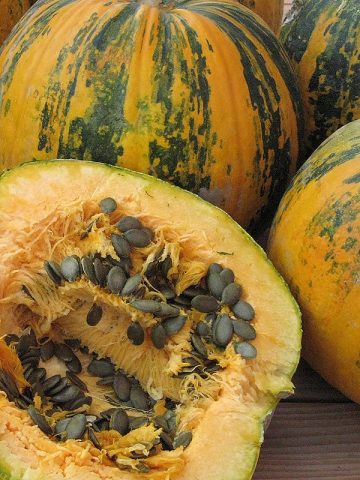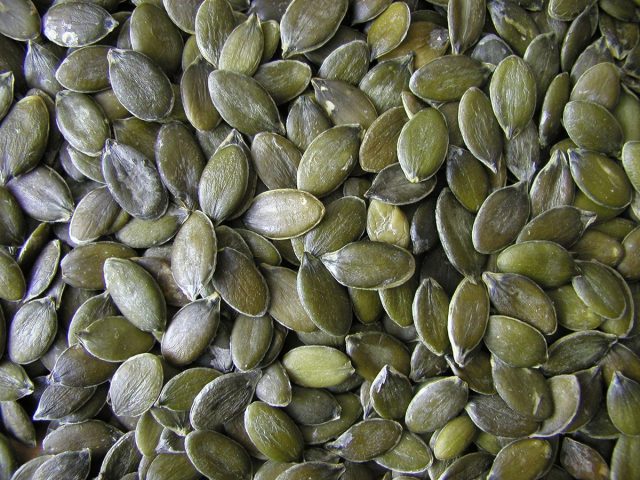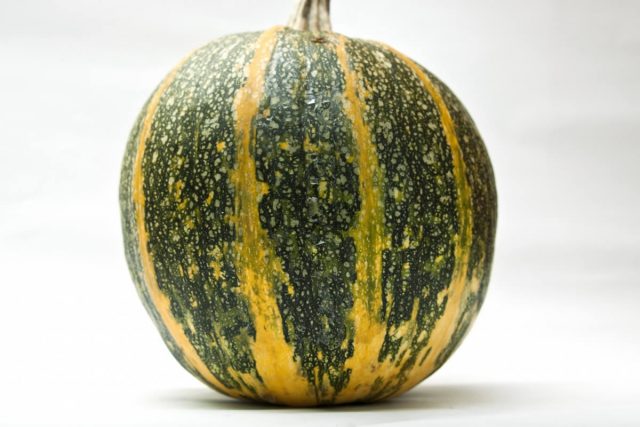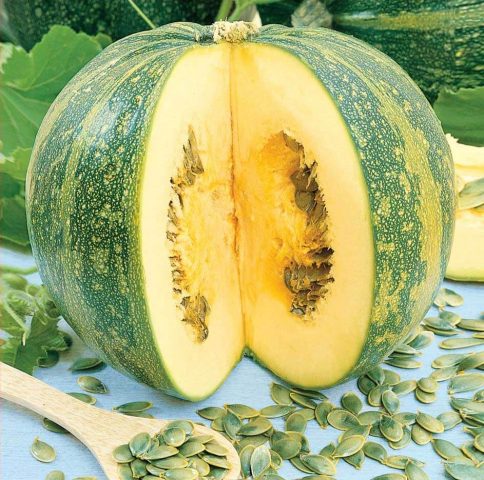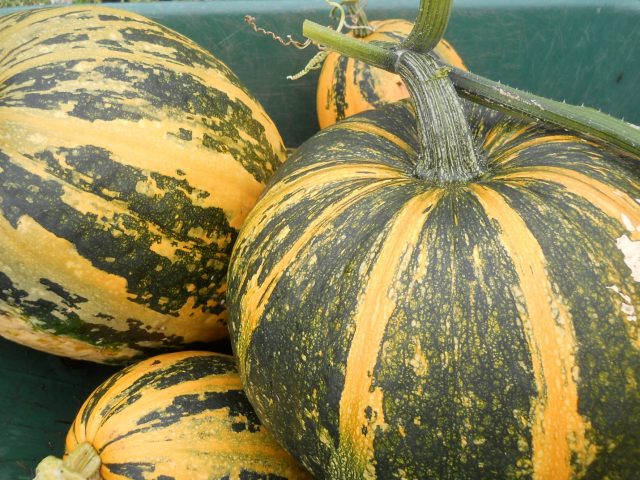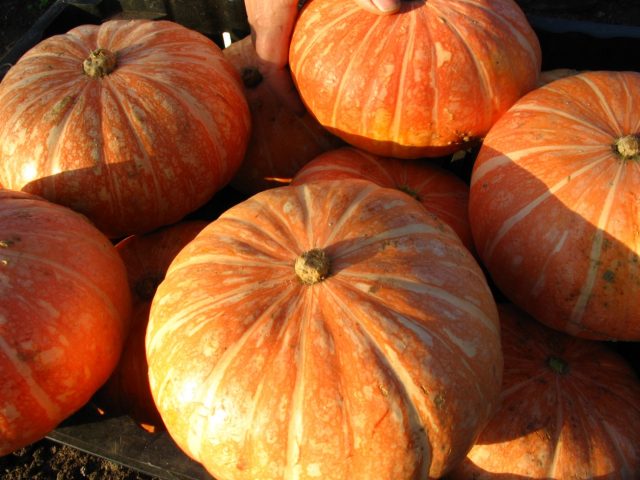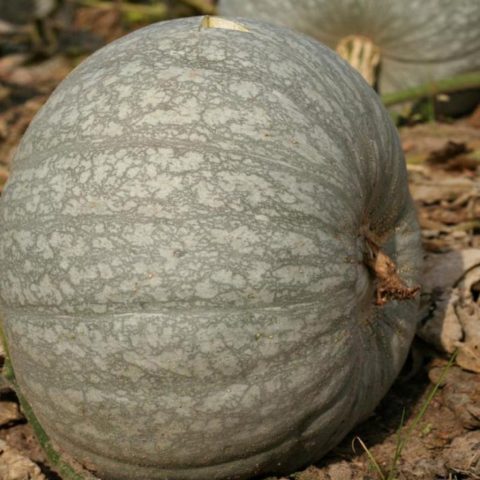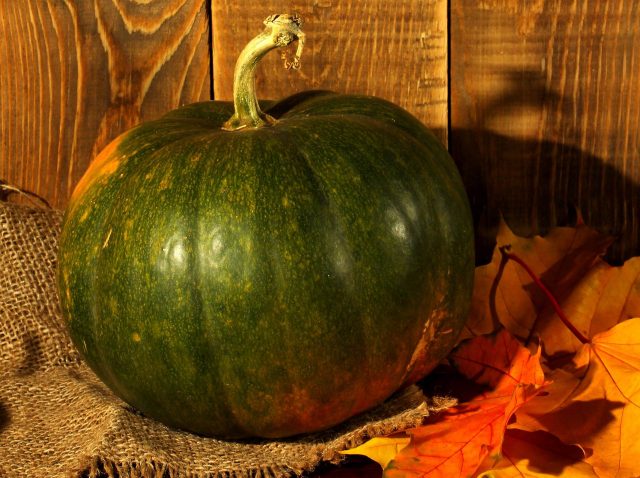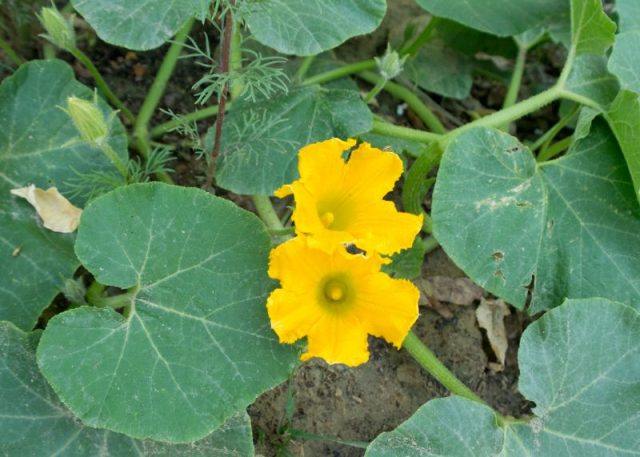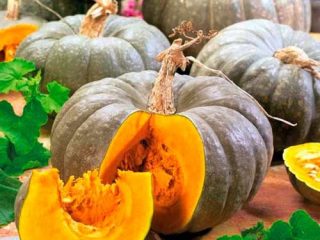Content
Gymnosperm pumpkin outwardly does not differ from ordinary pumpkin and is not a separate subtype of culture. Their agricultural technology is similar, the method of cultivation does not differ. The main advantage of gymnosperms is that the seeds are not covered with a hard shell, which makes them more convenient for processing.
General description of gymnosperm pumpkin
Gymnosperm pumpkin (pictured) has no visual difference from ordinary pumpkin. This herb with intensive growth and shoots can cover an area up to 30 m in 2-4 months. The culture is represented by a variety of varieties that differ in color and shape of the fruit. The basic requirements for growing conditions for gymnosperms and classic pumpkins are the same.
The biological characteristics of gymnosperms and common pumpkin do not differ. Depending on the variety, the crop ripens at about the same time. Gymnosperms are more sensitive to soil temperature during planting. Seeds unprotected by the shell germinate faster, but if the soil temperature is below +17 0C, the sprouts may die. Ordinary pumpkin is planted with seeds directly into the soil, gymnosperms are recommended to be grown by seedling method.
Gymnosperm pumpkin varieties do not produce large fruits, the average weight is from 6 to 8 kg. It forms more flowers than classical species, they are larger in size. General description of gymnospermous pumpkin:
- The lashes are hollow, long (up to 8 m), thick, some varieties require the formation of a bush by removing excess shoots. Stems are light green, ribbed, finely pubescent. The mustache is long and medium in size.
- The foliage is intense, the leaves are opposite, rounded, five-lobed, slightly dissected. The surface is smooth with thick veins, dark green, pubescent.
- On average, a pumpkin forms 70 female and more than 350 male flowers, male flowers appear first, then female ones grow at 4-8 internodes. The flowers are simple, solitary, bright yellow.
- The shape of the fruit and the mass depends on the variety, mainly rounded pumpkins with an orange color and dark green vertical stripes.
- Seeds of medium size are covered with a thin dark green film, are formed in large numbers, and are located in deep seed chambers.
The benefits and harms of gymnospermous pumpkin
There are many useful elements in the chemical composition of fruits, therefore they are widely used in recipes for traditional medicine and the pharmaceutical industry. Gymnosperm pumpkin in terms of the composition of the pulp does not differ from the usual. The seeds are useful in the fight against worms. The substance cucurbitin is contained in a film between the seed and the hard shell, in a normal pumpkin the film is thin. Cucurbitin is a green substance, in gymnosperms the film is much thicker, therefore the concentration of the substance is higher.
Beneficial features:
- Vitamins PP, B5, B1, E, B9 are involved in the metabolism of proteins, fats and carbohydrates, provide the body with energy. They synthesize hemoglobin, promote the production of amino acids, normalize the intestinal absorption function, and improve the adrenal glands.
- Thanks to choline, pumpkin has hepatoprotective properties.The substance is part of lecithin and participates in phospholipid metabolism, generates liver tissue.
- Phosphorus and zinc improve the condition of the walls of blood vessels, give them elasticity, and stop the formation of blood clots. They prevent the development of prostatitis and adenoma, zinc stimulates the production of testosterone and estrogen.
- Calcium helps to strengthen bone tissue.
- Amino acids improve brain function.
- Pumpkin has diuretic and choleretic properties, prevents the formation of stones in the bladder and ducts.
- Iron is involved in hematopoiesis.
- Omega-3 and Omega-6 fats moisturize the skin and have antioxidant properties. Together with vitamins, they normalize hormonal levels, thereby relieving acne.
- Seeds are used for helminthiasis caused by pinworms, tapeworms, bovine tapeworm.
The benefits of the seeds and pulp of gymnospermous pumpkin are beyond doubt, possible harm to the body is caused by excessive use:
- in people with dysbiosis, defecation may be impaired;
- in some cases, an allergic reaction to pumpkin occurs;
- people with diabetes are not recommended to get carried away with pumpkin seeds;
- in people with a violation of the acid-base balance, the condition may worsen.
Gymnosperm Pumpkin Varieties
The gymnosperm variety of culture was created to simplify the technology of processing seeds for oil. Later, varieties with improved gastronomic qualities were bred. A general overview of popular varieties of gymnosperm pumpkin and their name will help determine the choice of seeds for planting.
Styrian
Styrian gymnosperm pumpkin (Austrian) comes from the Austrian province of the same name. Created for the food industry, Styrian gymnosperm pumpkin seeds contain a high concentration of oils. The culture is adapted to the weather conditions in Russia. Grown on an industrial scale and in personal plots. Pulp with a low sugar content, with a subtle nutty smell.
Characteristics of Styrian gymnospermous pumpkin:
- medium late, matures in 3 months;
- heat-loving, demanding lighting;
- stems are long, bush with high shoots;
- fruits are round in shape, weighing 5-7 kg, the main color is green with light yellow lines.
- forms a large number of seeds of medium size, dark green in color.
Shelf life is 3 months.
Apricot
Gymnosperm pumpkin Apricot belongs to dessert varieties, created on the basis of Styrian, according to reviews, the varieties are similar in appearance. The surface of the fruit is bright yellow with green longitudinal stripes. It got its name for the taste of beige pulp. The taste is sweet, full-bodied, with hints of apricot. Seeds are medium, in large quantities. Advantages of gymnosperm pumpkin Apricot: taste and chemical composition of seeds. In the USSR, a crop was grown for the production of apricot juice. The variety is medium late, with intensive weaving, weight - up to 8 kg.
Golosemyanka
The biological characteristics of Golosemyanka pumpkin do not differ from other varieties of Austrian selection. The shrub plant is adapted to temperate climates, cultivated for technical purposes, to obtain oil. This is one of the first representatives of gymnosperms to appear in Russia.
Description of the variety and characteristics of the pumpkin Golosemyanka:
- medium late, fruits reach biological ripeness in 110 days;
- forms a small number of lashes, branched shoots, up to 4 m long;
- fruits are slightly flattened at the top and base, yellow and green, with a lack of light, green color dominates;
- the pulp is light yellow, slightly fibrous;
- the taste is neutral or slightly sweet;
It gives a lot of seeds, they have a dark gray tint.
Danae
According to reviews, the gymnospermous pumpkin Danae is the most demanded in the Middle Lane. A culture has been created in Rostov for technical cultivation.Description of pumpkin:
- frost-resistant, does not stop growing when the temperature drops;
- medium late, growing season 120 days;
- strongly branched bush with medium shoots;
- fruits are round, dark green, with a mesh pattern;
- the pulp is light yellow, unsweetened, fibrous;
- yields many large oil seeds. Sensitive to cross-pollination.
Olga
Olga is a gymnospermous pumpkin of early ripening. Created for dining purposes. The culture is semi-bushy, compact, the whips are short. Fruit ripening is simultaneous, pumpkins are leveled, weighing 1.5-3 kg. The pulp is juicy, sweet, slightly fibrous, rich yellow. The peel is tough, thin, the surface is orange with a light segment. Seeds are small, light green, formed in small quantities.
Juno
Gymnosperm pumpkin Juno belongs to the early maturing, because it ripens in 90 days. He is an unpretentious representative of culture. It is the only drought-resistant gymnosperm variety. The plant is spreading, intensively forms lateral shoots, stems are long, unlimited in growth. Poorly tolerates a tight fit and a dense crown. Requires the formation of a bush. The culture is high-yielding, the fruits are of a uniform shape, color standard for gymnosperms. Pumpkin weight up to 8 kg. The seed cover is dark, closer to black; a lot of seeds are formed.
Miranda
Miranda is a gymnosperm representative of the Polish selection, a semi-bushy undersized plant. The bush is not sprawling, compact, does not take up much space on the site. Description of the variety:
- medium late (105-110 days);
- shoot formation is weak;
- high yield;
- table variety;
- fruits of a rounded flattened shape, at the stage of technical ripeness are green, when ripe they turn gray with a marble pattern, weight - 5-8 kg;
- the pulp is juicy, up to 7 cm thick, with a high content of starch and sugars;
- gives some light green seeds.
Eso
The copyright holder of the gymnosperm variety is the Czech company SEMO, a leading supplier of seeds on the European market. The variety was created for industrial cultivation. Fully adapted to the weather conditions in Russia. Gymnosperm pumpkin of this variety belongs to mid-season crops, 110 days are enough for full ripening. The plant is climbing, occupies large areas. It is grown only for obtaining seeds. The pulp has a neutral taste, thin, light yellow. Fruits are round, dark green, with a slight yellow blotch, weight up to 9 kg. The rind is tough, thin. You can store the pumpkin for up to 1.5 months. After harvesting, the fruits are immediately processed.
Growing gymnosperms pumpkin
Gymnosperm pumpkin is a light-loving culture, it prefers areas open to the sun, protected from the north wind. The best cultivation option is on a hill on the south side. Drought resistance in gymnosperms is low, plants require constant watering for vegetation. The root system is superficial, so waterlogging of the soil can lead to diseases, in the worst case, to the death of the plant.
The required composition of the soil for the culture is neutral or slightly alkaline; on acidic soil, gymnosperms will not yield a crop. The soil should be light, aerated, drained, fertile. So that nitrogen, potassium and phosphorus were in the required amount. Replenish the stock with the help of feeding and crop rotation. On one site for more than 3 years, gymnosperms are not planted, the soil after growing melons will not work.
Distribute vegetables on the site in such a way that there is no ordinary pumpkin next to the gymnosperms. Plants are pollinated, planting material for the next year will not give the desired variety. The garden bed is prepared before planting: they dig up and add organic matter. Moisten before sowing. The timing of planting seeds for each climatic zone is different. A prerequisite for the soil to warm up to +17 0C, and there was no threat of frost.Seeds germinate on the seventh day, if at this moment frosts occur, then the plant will no longer recover.
Planting work:
- The seeds are heated for 8 hours at a temperature not higher than +40 0C.
- Then placed for 5 hours in a solution of the drug "Vympel".
- Depressions of 30x30 cm are made, poured with a solution of ash (100 g) and potassium sulfate (100 g) at the rate of 2 water.
- Mix humus (5 kg) with superphosphate (100 g), put on the bottom of the hole, a layer of about 15 cm should be obtained.
- 4 seeds are planted to a depth of 5 cm, keeping a distance between the seeds of 4 cm.
- Cover with soil, mulch with straw or sawdust.
Direct planting in the ground is used in the southern regions. For temperate climates, seedlings are pre-grown to speed up the ripening period. Gymnosperm pumpkin reacts poorly to transplantation, so seeds are sown in peat glasses.
Growing seedlings:
- By the time of sowing the seeds, they are guided by the weather conditions, the seedlings will be ready for planting in 1 month.
- In glasses, soil is poured, consisting of peat, compost and topsoil in equal parts.
- Seeds are planted to a depth of 4 cm.
- Grow pumpkin at a temperature of 22 0C, creating illumination for 16 hours a day.
- When leaves appear, the seedlings are fed with Uniflor Growth.
Before being placed in the garden, the seedlings are taken out to fresh air for several hours.
Sowing seeds and planting seedlings are carried out according to the same scheme. The row spacing is 70 cm, if the variety is bush, then between plants - 65 cm, medium-growing - 1.5 m, with intensive shoots - 2 m.
Gymnosperm Pumpkin Care:
- Watering every evening at the root.
- Weeding and loosening as needed.
- Top dressing with preparations "Uniflor-micro", "Azofoska", organic.
- Lateral shoots are removed, 4 to 7 ovaries are left on the bush, depending on the variety, the tops are broken.
When the fruits begin to ripen, they need to be placed on a layer of straw so that they do not come into contact with the ground or tied to a support.
Pests and diseases
Gymnosperm pumpkin varieties are selective, created by selecting high-quality planting material, so the culture has a stable immunity. The most common diseases are powdery mildew and anthracnose.
Powdery mildew is a fungal disease that manifests itself as gray spots on the leaves. The reason is excess nitrogen, lack of moisture, cold damp weather. Control methods:
- removal of problem areas;
- processing gymnosperms pumpkin with sodium phosphate or colloidal sulfur;
- using the drug "Topaz" or "Universal Dew".
The first signs of anthracnose are the appearance of dark yellow spots, over time they increase in size, become dark pink. The fungus infects gymnospermous pumpkin completely, the fruits are unusable. If the plant is infected, it will not be possible to save it, the bush is completely removed from the site. Preventive action:
- compliance with crop rotation;
- disinfection of planting material with antifungal agents;
- treatment of the beds before planting with a fungicide;
- removing pumpkin residues and weeds after collecting from the site.
It parasitizes aphids on pumpkin, gets rid of the pest with Iskra, Fitoverm. The moth "Whitefly" is less common, caterpillars are destroyed by the "Commander".
Harvesting and storage
A sign that the gymnosperm is ripe is the rich color of the fruit and the dry stalk. The timing of harvesting depends on the variety and region of growth. Basically, this is autumn - mid September for a temperate climate, in the South - early October. Collect the pumpkin with the stalk. Gymnosperm varieties do not have a long shelf life, the fruits begin to rot, the seeds germinate inside. The average shelf life is 60 days, Styrian gymnosperms are stored for 1 month longer.
Storage conditions for pumpkin:
- dark room with a temperature not higher than +10 0C;
- air humidity - up to 80%;
- the fruits are placed on a hill (cannot be stored on the ground), they are shifted with straw so that they do not come into contact with each other;
- periodically revised.
If signs of rotting appear, gymnosperms must be removed from storage, damaged areas removed and processed.
Conclusion
Gymnosperm pumpkin is a type of common pumpkin, mid-season, light-loving, with low drought resistance. The plant is cultivated for its seeds, which are used in the food industry. There is no upper hard layer on them, which is economically beneficial in the processing process.
